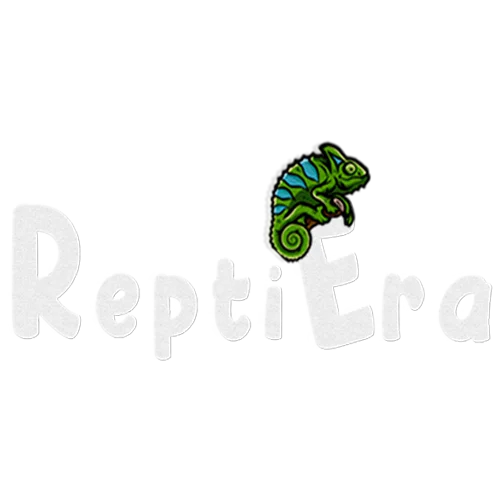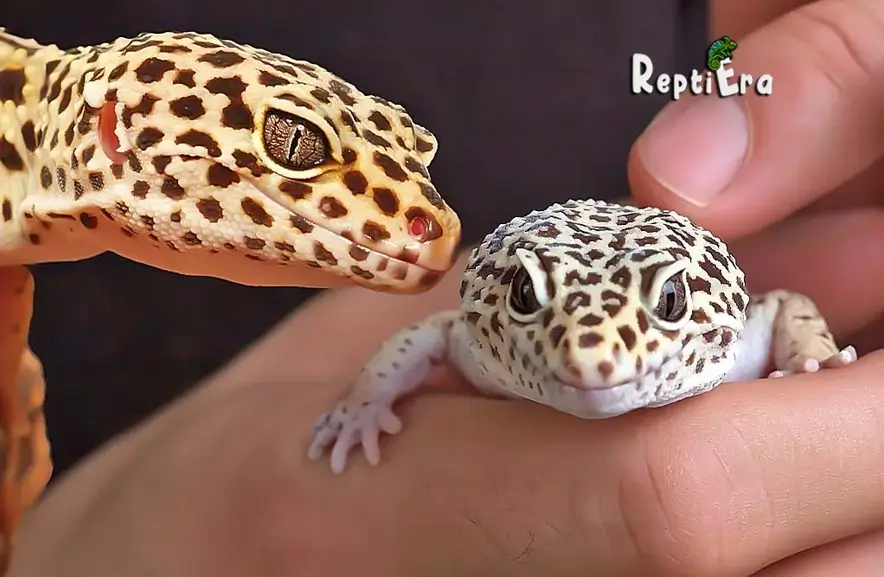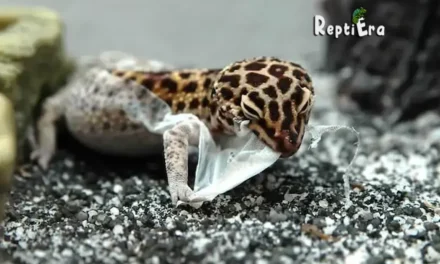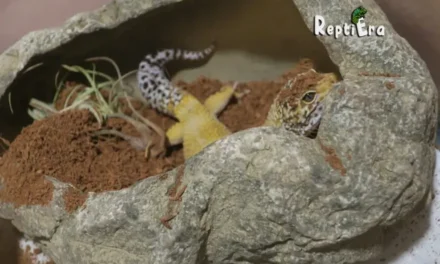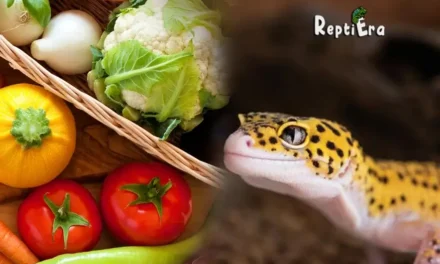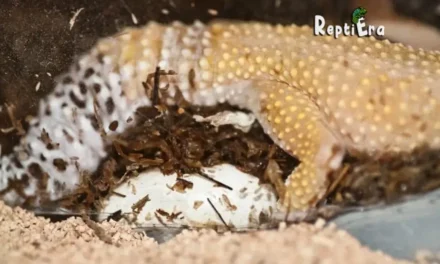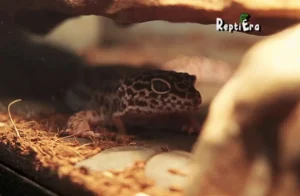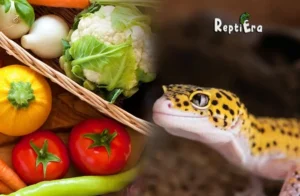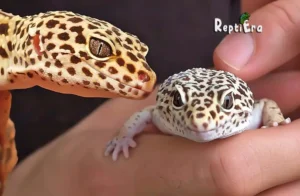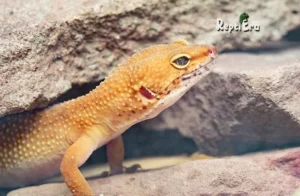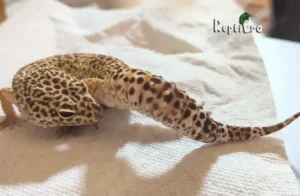Leopard geckos have soared in popularity as pet lizards around the world, becoming a top choice for both beginners and experienced keepers. Despite the lack of hard numbers to track down their exact status, they are undoubtedly among the most sought-after pet lizards.
They are a frequent sight in tanks at pet stores, readily available on online platforms, and are stars of pet expos and swap meets. This popularity isn’t just hype; it’s well justified, as these creatures are more than just good pets; they are often recommended by experienced keepers to those starting their journey into reptile care.
Are Leopard Geckos Good Pets?
The requirements of leopard geckos, encompassing both dietary and environmental needs, are well within the capability of most pet owners. Their management regimen is not overly demanding, making it easier for novice keepers to employ and keep them healthy. When it comes to interacting with these geckos, many find them to be fantastic pets due to their tolerance for handling.
This aspect is particularly appealing to novice keepers, who are often most interested in the hands-on experience. At the outset, without the risk of extinguishing any drama this question might present, it’s clear that leopard geckos stand out as fantastic pets for a wide range of enthusiasts.
Table of Contents
Getting to Know Leopard Geckos
Leopard geckos (Eublepharis macularius) are fascinating small lizards, native to rocky-soiled grasslands stretching from eastern Iran to parts of Nepal and India. They are distinctive for their large, rounded tails and the presence of eyelids, a trait not common in other gecko species. Typically, they measure between 8 and 11 inches in total length, making them a manageable size for pet owners. These terrestrial creatures, unlike their tree-dwelling counterparts, have a unique lifestyle and reproductive pattern, often depositing two eggs per clutch throughout the breeding season.
In terms of diet, leopard geckos are carnivorous, primarily feasting on large insects, arachnids, and the occasional small lizard. Their nocturnal nature makes them active during both the day and night, adapting well to various environments. In the modern US pet-keeping market, most leopard geckos available are captive-bred individuals, successfully bred in skilled hands.
The wild variants of these geckos are typically pale grey with darker spots and often exhibit bands of purple or yellow tones. Breeders have developed numerous colour mutations, presenting jaw-dropping colour and pattern schemes for potential keepers to choose from, adding to their appeal as pets.
6 Reasons Leopard Geckos Make Good Pets
1. They are easy to care for
Reptile care often involves specialized housing, heating, and lighting, which can be daunting for some owners. However, Leopard geckos stand out as they require these elements but are not overly sensitive to parameters. This means they can tolerate small mistakes in husbandry, making them particularly forgiving for novice owners. Maintaining a leopard gecko is notably simpler when compared to other reptiles, primarily due to their small size. This aspect makes caring for them easier, as their tanks require a shorter time to clean. All these factors contribute to leopard geckos being ideal pets, especially for those new to reptile care.
2. They are relatively inexpensive
Leopard geckos stand out for being economically feasible pets, especially when maintenance costs are considered. Their basic requirements, such as a smaller tank and low-level UVB lighting, significantly lower the ongoing expenses compared to many other reptiles. As insectivores, leopard geckos offer an added advantage for owners; there is the option to breed their insects, like crickets, which can lead to substantial savings in feeding costs. This aspect makes them an attractive choice for those looking for a pet that doesn’t strain the budget, while still providing the joy and companionship that comes with pet ownership.
3. They tolerate handling
Leopard geckos are known for their slow-moving and docile nature, making them particularly good for beginners and children under adult supervision. One of the notable traits of these creatures is their ability to tolerate handling, a characteristic not always shared by other reptiles. They can get used to handling with minimal training, learning to associate human touch with safety and care. However, it’s crucial to never force handling on a leopard gecko; gentle and patient introduction is key. This level of tolerance and adaptability in handling makes them ideal pets for those who desire a more interactive experience with their reptilian companions.
4. They are hardy lizards that have a long lifespan
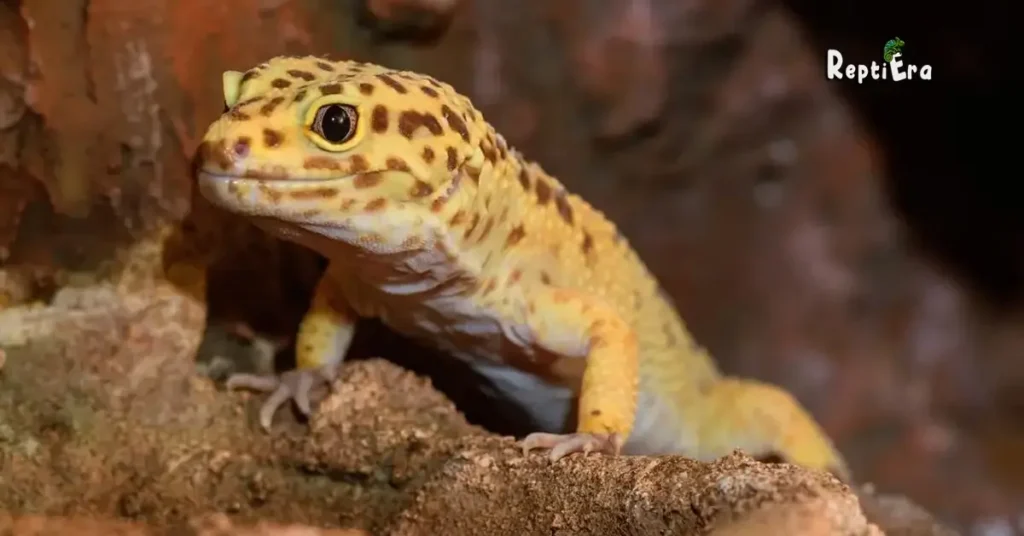
Leopard geckos are celebrated for their durability and longevity, attributes that make them ideal pets. Remarkably, these hardy reptiles can live up to 25 years in captivity with good care, providing a long-term companionship opportunity for reptile enthusiasts. Their resilience partly stems from their adaptability; they are not too sensitive to minor fluctuations in their environment, unlike some other reptile species.
This attribute simplifies the care process, allowing even novice owners to successfully nurture them over the decades. Their enduring presence and the extended bond they offer make leopard geckos a rewarding choice for those seeking a pet with a significant lifespan.
5. They are cute and unique
Leopard geckos stand apart from most geckos due to their distinctive vertical slit pupils and movable eyelids, features that contribute to their unique and curious look. Their big eyes and bright colours make them particularly attractive and allow them to stand out in the world of pet reptiles. The availability of various colour morphs enhances their appeal, offering a range of visually striking options for enthusiasts.
Additionally, their small size is a significant advantage, especially for beginners and families with kids. These characteristics collectively make leopard geckos great pet reptiles that are not only charming but also accessible to a broad range of pet owners. Their cuteness and uniqueness are among the many reasons they are favoured in the pet world.
6. They are easy to breed
For those interested in breeding these charming creatures, Leopard geckos present a convenient choice as they do not require overly complex breeding setups. Remarkably, they usually breed on their own, without demanding any special needs or intensive intervention. In a breeding scenario, a male can be comfortably kept with multiple females, facilitating a straightforward breeding process.
However, it’s crucial to note that males can be aggressive toward each other, necessitating separate enclosures to prevent conflicts. Maintaining leopard geckos for breeding purposes is made easier by their small size and ease of care, making them a popular choice among both novice and experienced breeders. This ease of breeding contributes to their appeal as pets and offers an engaging aspect of leopard gecko care for enthusiasts.
Reasons Why Leopard Geckos Don’t Make Good Pets
Despite their popularity, there are usual trade-offs when it comes to caring for lizards like Leopard geckos. These charming reptiles do require specific care tailored to their species, which might not align with everyone’s expectations or abilities. For example, owners need to spot-clean the enclosure every day to maintain hygiene, a task that might be tedious for some.
Additionally, monitoring the tank temperature to ensure it stays within the correct range is vital for the gecko’s health but can be seen as cumbersome. This type of attentive care, while necessary for the well-being of Leopard geckos, might not be everyone’s cup of tea, especially for those looking for a more low-maintenance pet. Hence, while Leopard geckos have many qualities that make them appealing as pets, their specific care requirements may not suit every potential pet owner’s lifestyle or preferences.
1. They shed a lot
Adult Leopard geckos typically shed every 6-8 weeks, a process that might be challenging for some owners to manage. Shedding issues can arise if the gecko is not well hydrated, potentially leading to a serious condition that may require a vet check-up. Hatchlings and juveniles, due to their rapid growth rate stage, shed more frequently, about every 10 days.
This frequency gradually decreases as they age, shedding weekly until about 3 months of age, then once every two weeks from 3-6 months, and eventually settling to monthly sheds from 6 months to 1.5 years. This high frequency of shedding in their early life stages can be demanding for owners not prepared for such regular care.
2. They can drop their tails
Leopard geckos possess a unique defence mechanism; they can drop their tails when threatened. This survival tactic, while effective in the wild, means that in a domestic setting, they may require more attention during the recovery phase. The regrown tail often does not look the same as the original, which can be a concern for owners seeking a particular aesthetic. This aspect of their biology necessitates additional care and attention from pet owners, especially in ensuring a stress-free environment to minimize the likelihood of tail dropping.
3. They can carry Salmonella and other infections
Reptiles, including leopard geckos, are susceptible to carrying Salmonella and other microbial infections that can affect humans. This potential health risk highlights the importance of ensuring their cage is well maintained and kept clean. Responsible pet ownership involves regular cleaning and hygiene practices to minimize the risk of transmission. It’s crucial for owners to be aware of this aspect and take appropriate preventative measures, especially when handling their pets and cleaning their enclosures, to protect both the health of the gecko and their own.
Common Health Problems
Common health problems that leopard geckos are prone to include:
Metabolic bone disease
Metabolic bone disease is one of the most severe conditions that can affect leopard geckos, similar to how humans become ill when they don’t get enough calcium and vitamin D. This ailment causes painful deformities in the spine and limbs of the geckos. Owners must ensure their pets receive adequate nutrition, especially calcium and vitamin D, to prevent such painful consequences. Regular check-ups and a balanced diet are key to keeping this debilitating condition at bay.
Armpit bubbles
In leopard geckos, armpit bubbles are a not dangerous but telling sign that the lizard is storing excess resources. These bubbles can contain fat, vitamins, protein, calcium, and other minerals. They are particularly common in overweight geckos. Observing these bubbles can be a cue for owners to reassess their pet’s diet and exercise. Fortunately, these bubbles typically go away when the gecko returns to a healthy weight.
Gastroenteritis
Gastroenteritis in leopard geckos is a condition often caused by a bacterial infection. Key signs include watery stools and a tail that shrinks. These symptoms can indicate that the gecko is suffering from gastroenteritis. While this condition can be potentially fatal, it remains treatable if caught early. Prompt veterinary care is crucial in managing this condition effectively.
Dysecdysis
Dysecdysis, a condition resembling dry skin, can occur in leopard geckos, especially when they are undernourished or their cage has insufficient moisture. This condition leads to difficulty in shedding, potentially affecting their vision and even constricting their fingers and toes. Owners must monitor their lizard’s environment and diet to prevent this condition.
Respiratory infections
Leopard geckos are susceptible to a variety of respiratory infections, including pneumonia. Signs like wheezing or bubbles of mucus around their nasal passages and mouth are indicators of respiratory problems. Owners should be vigilant for these symptoms to ensure prompt veterinary care.
Choosing Your Leopard Gecko
When considering leopard geckos as pets, it’s essential to remember they are long-lived lizards that require extended care. These highly popular pets are readily available for purchase from reputable breeders, typically costing between $20 and $40, although rare morphs might cost up to $100. You can often find a trusted reptile breeder at a reptile expo or reptile show.
When choosing your pet, look for a tail that is plump and fat, ideally as wide as the space between the gecko’s shoulders. The eyes, nose, and mouth should be clear and not runny, and the vent (the opening for urinating and defecating) should appear clean and not swollen. This level of scrutiny ensures you start with a healthy gecko, setting the stage for a rewarding pet ownership experience.
Housing Your Leopard Gecko: Simple and Straightforward
Leopard geckos, being relatively small and not especially active lizards, don’t need large enclosures, making their housing straightforward and manageable. For juveniles, a 10-gallon-sized habitat is typically comfortable, while adults will thrive in a habitat of about 20 gallons of cage space. When it comes to choosing the enclosure, aquaria are a common choice due to their ubiquity and low cost.
However, there are other options such as commercially built reptile enclosures or even storage boxes, though the latter may not provide a good view of your lizard. Regardless of the style of habitat you choose, you’ll find something suitable easily and at a relatively modest price, without the worry of it taking up a large amount of space in your home.
Substrate and Enclosure Furniture
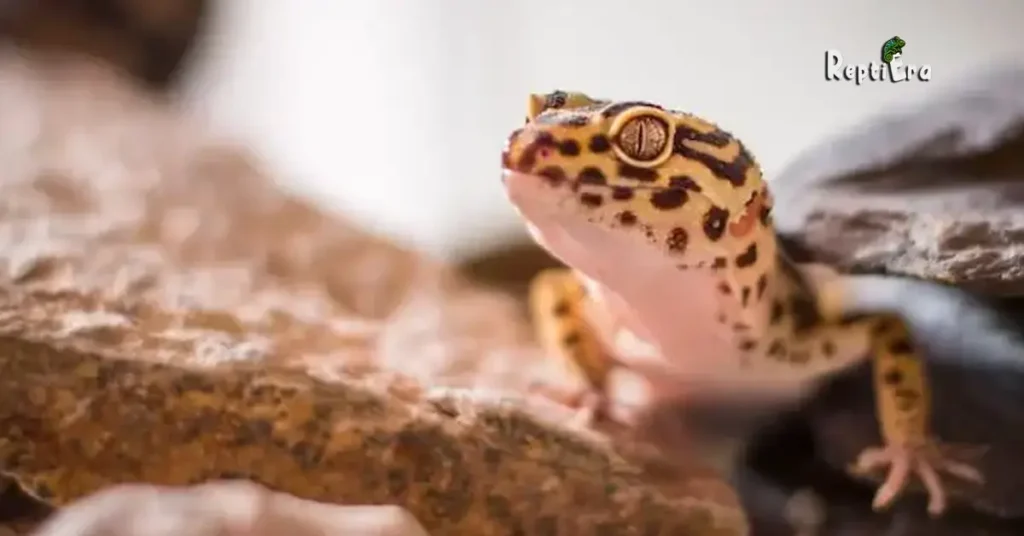
When selecting a habitat for Leopard geckos, it’s essential to fill it with the right items to keep your pet healthy and happy. Leopard geckos don’t require a lot of things, which further illustrates their suitability as pets. However, a few essentials they need include a suitable substrate for comfort, hiding spots for privacy, and a water dish for hydration. Decorations are optional but can enhance the enclosure’s aesthetics. It’s important to discuss and understand the basic items you’ll provide to create a suitable environment for your lizard, ensuring their well-being and comfort in their new home.
Substrate for Leopard Geckos
Choosing the right substrate for your leopard gecko’s enclosure is crucial to provide a comfortable surface for your pet and to effectively absorb any liquids they release. For beginners, the newspaper is an excellent option, being free (or nearly so), easy to remove and replace, and typically alleviating any ingestion concerns. While not particularly attractive, sand is another acceptable substrate for leopard geckos, particularly when a smooth-grained variety is used to prevent abrading or clogging the digestive tract should your gecko eat some of it. You can spot-clean sand, reducing the frequency of complete substrate changes.
Despite impaction and desiccating risks, as leopard geckos are from dry habitats but not deserts, alternatives like wood chips or cypress mulch are preferred by some, including this author, due to their affordability, safety, and aesthetic appeal.
Hiding Spots
Leopard geckos are naturally secretive animals that tend to spend a lot of time hiding, both in the wild and in captivity. If they are forced to hang out exposed for too long, they can become stressed. Therefore, it’s essential to provide your lizards with adequate hiding places. These hiding places don’t have to be elaborate; something as simple as a partially crumpled piece of newspaper or a paper towel tube will often suffice.
However, if you prefer a more decorative approach, ensure you clean these hiding spots regularly to maintain a healthy environment. In an ideal situation, you should place one hide on the warm side of your gecko’s tank and another on the cool side, allowing your pet to choose between security and its preferred temperature without compromise.
Water Dish
One of the reasons leopard geckos are considered good pets is their willingness to drink from a water dish, a behaviour some lizards refuse. This trait makes keeping your pet hydrated a breeze. It’s best to Provide your lizard with a small, shallow dish, consistently filled with clean, fresh, and cool water at all times to ensure their hydration needs are met.
While you can opt for decorative water dishes, it is often easier to maintain and keep simple dishes clean. If you’re feeling creative, even Tupperware containers or glass ashtrays can serve as practical and unconventional water dishes for your pet gecko.
Decorations
While decorations in your leopard gecko’s habitat are not necessary from your pet’s point of view, you can certainly add them if you wish. However, it’s crucial to be careful to avoid cluttering the tank, ensuring your gecko still has plenty of space to explore. When selecting decorations, you can practically use anything as long as it does not pose a safety hazard to your lizard. This freedom allows you to personalize their space while maintaining their comfort and safety.
How to Care for a Pet Leopard Gecko
The leopard gecko is a popular choice as a beginner’s reptile due to its easy-to-handle nature and minimal care requirements, making it stand out among other lizards. Native to regions like Afghanistan, Pakistan, northwest India, and Iran, these captivating reptiles are known for their perky personalities and movements that are interesting to watch. Their commonly yellow, white, and black dotted appearance makes them visually appealing, especially considering hatchlings start with a striped look that evolves into a spotted appearance as they mature.
Moreover, the colourful and patterned morphs or variations available in leopard geckos offer a wide range of aesthetics, adding to their appeal as a pets. Their unique characteristics combined with ease of care make them an ideal choice for both novice and experienced reptile enthusiasts.
Habitat Maintenance: Keeping Your Pet’s Habitat Clean
Maintaining your leopard gecko’s habitat is an easy yet important aspect of their care. To keep your pet’s habitat clean, there are essentially two types of habitat maintenance: daily spot-cleaning and once-per-month complete habitat cleaning. The former involves a quick look through the habitat to remove urates, shed skin, and faeces, followed by emptying, washing, and re-filling the water dish, and a routine check of the temperatures to ensure your lizard is comfortable.
Monthly, in-depth cage cleaning sessions are more work but are still simple relative to caring for other lizards. This involves removing all enclosure furniture and washing all the durable items, disposing of the substrate, cleaning the entire enclosure with a reptile-safe disinfectant, and then replacing the substrate and furniture. Return your lizard to their home, and you’re finished.
Typically, spot cleaning takes about five minutes, while monthly in-depth cleanings shouldn’t take more than one-half hour. In contrast, owners of many other reptiles often find themselves needing to spend much more time on habitat maintenance.
Ringing the Dinner Bell: Providing Food and Water
When it comes to feeding your leopard gecko, the process is surprisingly easy. These carnivorous lizards remain healthy and well-fed on a diet predominantly of crickets, which they can thrive on for their entire lives. You can mix in other insects like mealworms or wax worms from time to time, though it’s not strictly necessary.
At feeding time, just collect 5 to 10 crickets and toss them into the enclosure; your gecko will track down these tasty morsels in short order, leaving you with a satiated pet. It’s also essential to dust the insects with a vitamin and mineral supplement on a periodic basis. The frequency of this supplementation can vary, so it’s wise to discuss the best regimen with your vet, taking into account your gecko’s sex, age, and overall health status to determine the ideal supplementation schedule.
Providing water is equally straightforward. Simply place a shallow bowl in the enclosure and keep it filled with fresh, clean water at all times. Unlike many other lizards that do not recognize standing water, leopard geckos will readily drink from a dish, making hydration a breeze for both you and your pet. This ease of care in both feeding and hydration adds to the allure of leopard geckos as ideal pets, especially for beginners in reptile care.
Leopard Gecko Behavior and Temperament
Leopard geckos, affectionately known as Leos, are renowned for being easy to care for, requiring minimal cage maintenance and environmental attention. These mostly nocturnal and ground-dwelling creatures are known for their docile and easy-to-tame nature. Unlike other geckos, they don’t have sticky toe pads and hence, do not climb walls, but they do possess eyelids.
Leopard geckos are not prone to biting and are generally slow-moving, making them ideal for beginners. When hungry, they can be quite vocal, emitting chirps and squeaks. They can be socialized through gentle handling and are known to tolerate a certain amount of contact, but overdoing it can make them stressed.
Their tails are an integral part of their communication; in an enclosure, tail-waving, a back-and-forth motion, often signifies that they feel threatened and might attack, prompting the need to separate them from other geckos. Additionally, leopard geckos are tail rattlers, similar to rattlesnakes, where they rattle the tip of their tail rapidly when excited to eat or mate. Another fascinating aspect is their ability to self-amputate their tails as a defence mechanism, a trait shared with many other lizards.
Heat
Heat management is crucial for leopard geckos, as these cold-blooded creatures depend on their environment to regulate their body temperature. A regular white light incandescent heat bulb is ideal for creating a basking spot during the day, but it should be turned off at night. For nighttime, options like a red heat bulb, purple heat bulb, or a ceramic heat emitter can provide supplemental heat.
A blue heat bulb can also be used for daytime heating. While under-tank heating pads are another method for heating, they may not be as effective in regulating your gecko’s temperature properly and, if the gecko burrows down to the glass surface of the tank, might cause burns. Therefore, hot rocks should be avoided.
To maintain a healthy thermal gradient, provide a daytime basking spot of around 88 degrees Fahrenheit (31 degrees Celsius) and allow the temperature to drop to 70–75 Fahrenheit (21–24 Celsius) at night. It’s vital to ensure your gecko is not exposed to drafts and to avoid placing the tank near a window or door, where temperature fluctuations are more likely.
Light
For nocturnal leopard geckos, active mostly at night, UV lighting is not as crucial as for other reptiles, but a small amount of UVA and UVB light (2 percent to 7 percent) can be beneficial. In the wild, these geckos are active around dawn and sunset, receiving UV exposure during scant sunlight.
This light exposure is essential for maintaining vitamin D levels and reducing the risk of metabolic bone disease. To mimic sunlight in captivity, incandescent lighting can be used, providing around 14 hours of ‘sun’ per day in summer and 12 hours in winter. To ensure the proper exposure to the right lighting and heat source, consider automating the cage lighting with a timer. This approach ensures that the geckos receive consistent light cycles, crucial for their health and well-being.
Humidity
As desert lizards, Leopard geckos thrive in an environment that is not highly humid. However, it’s vital to keep the humidity level within the 30 to 40 percent range, which is similar to the humidity in a typical home. If the humidity drops below 20 percent, geckos might have trouble shedding, a critical aspect of their health.
To maintain this ideal humidity, use a regular screen top coupled with a heat source to keep the environment dry. Regularly check the humidity with a hygrometer or humidity gauge in the cage to ensure it remains within this optimal range, thereby providing a comfortable and healthy living space for your leopard gecko.
Are Leopard Geckos Good Pets? The Bottom Line
Leopard geckos are often agreed upon as fantastic pets, especially when considering the best pet lizard for beginners. They stand in a league with crested geckos and bearded dragons, providing a gentle introduction to the world of reptile care, yet also being enjoyable for advanced keepers.
A few things that make leopard geckos excellent pets include their small size and modest activity level, which means they do not require large enclosures, making them a perfect fit for most homes. Additionally, you won’t need to spend a ton of money on their habitat or elaborate lighting, simplifying their care and helping you save money.
Moreover, providing appropriate temperatures for leopard geckos is relatively straightforward, as they do not require the high temperatures needed by some heliothermic (sun-loving) lizards. These excellent eaters primarily require insects for food, sparing you the hassle of maintaining a colony of live insects or making frequent trips to the pet store, unlike many carnivorous lizards. Importantly, they will never require vertebrate prey.
Furthermore, their ability to drink from a water dish simplifies meeting their hydration needs. All these factors combined firmly establish leopard geckos not just as suitable pets for beginners, but as rewarding companions for reptile enthusiasts at any level.
FAQs
How long do leopard geckos live?
Leopard geckos typically live between 10-20 years in captivity, with their lifespan depending on the quality of care, environmental conditions, and genetic predisposition. This impressive longevity makes them a long-term commitment, requiring consistent care and attention to thrive throughout their lives. Owners should be prepared for the dedication needed to support their pet’s health and well-being for potentially two decades.
Do leopard geckos like to be held?
Probably not inherently, as Leopard geckos are not naturally inclined towards handling like some other reptiles. However, with gradual training and exposure, they can learn to tolerate it. Owners should be careful, especially with their tails, as they can drop them when they feel threatened or stressed.
Are leopard geckos friendly pets?
Leopard geckos are known for their docile and slow-moving nature, even in the wild. Their calm temperament and handling tolerance contribute to their reputation as friendly pets, making them a favoured choice among reptile enthusiasts.
Are leopard geckos easy to keep?
Yes, Leopard geckos are easy to care for, as they do not have strict lighting requirements and only eat insects. Their relatively smaller size makes their enclosures easier to maintain, offering a convenient option for both novice and experienced pet owners.
Do leopard geckos like to be held?
Leopard geckos can get used to being held and often don’t mind it, but it ultimately depends on the individual lizard. The key is to Approach your gecko gently and slowly, being consistent so they can gradually become accustomed to your warm hands without fear.
What do leopard geckos eat?
Leopard geckos are insectivores and only eat insects, with their favourites including mealworms, crickets, waxworms, dubia roaches, and superworms. They should be fed every day or every other day, and it’s crucial to always have fresh water available for them.
How big do leopard geckos get?
Including their tails, geckos grow to be 8 to 10 inches long, making them a fairly small reptile. Their size contributes to their manageability as pets, especially for beginners.
How often do leopard geckos shed?
Adult leopard geckos shed every four to eight weeks, while young ones shed more frequently due to their rapidly growing nature. The shedding process typically takes 24 to 48 hours to finish a complete shed.
Conclusion
From the very beginning, it’s clear to see why leopard geckos have become popular as pets. They’re not just animals to be spoiled but companions to learn from. Understanding a pet’s needs and being able to provide a comfortable home and a high quality of life are key to owning any pet, and leopard geckos are no exception. They stand out among reptile pets due to their relative ease of care, especially since most are captive-bred. This makes them an ideal choice for the individual considering purchasing their first reptile.
When setting up their habitat and acquiring the necessary associated equipment, it’s more than just buying a lizard; it’s about forging a relationship with a unique creature. Consulting a reptile-oriented veterinarian can enhance this experience, ensuring you enjoy your pet for many years to come. The key is to approach pet ownership with responsibility and a willingness to learn, which makes the journey of owning a leopard gecko both rewarding and enriching.
